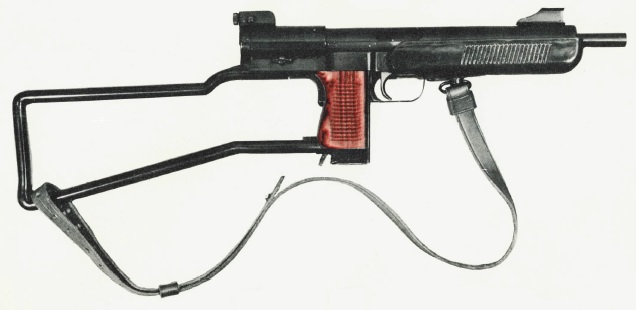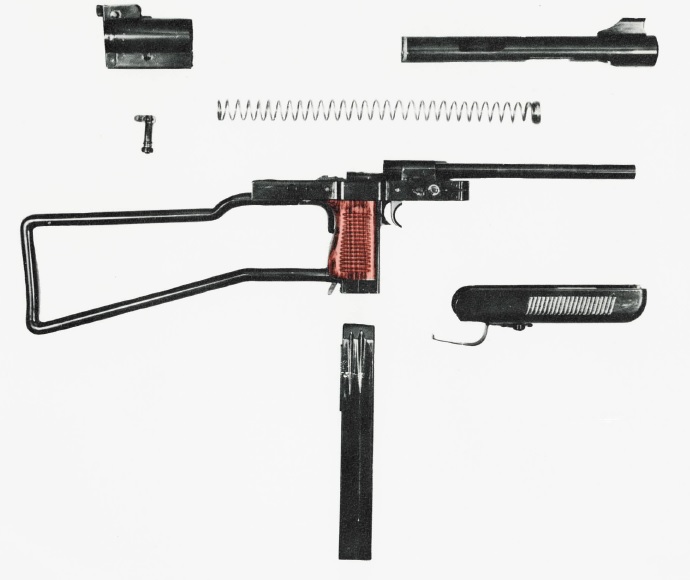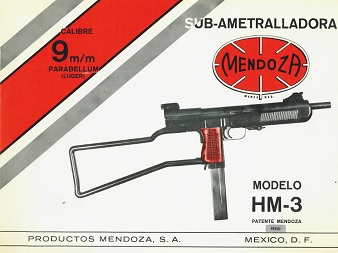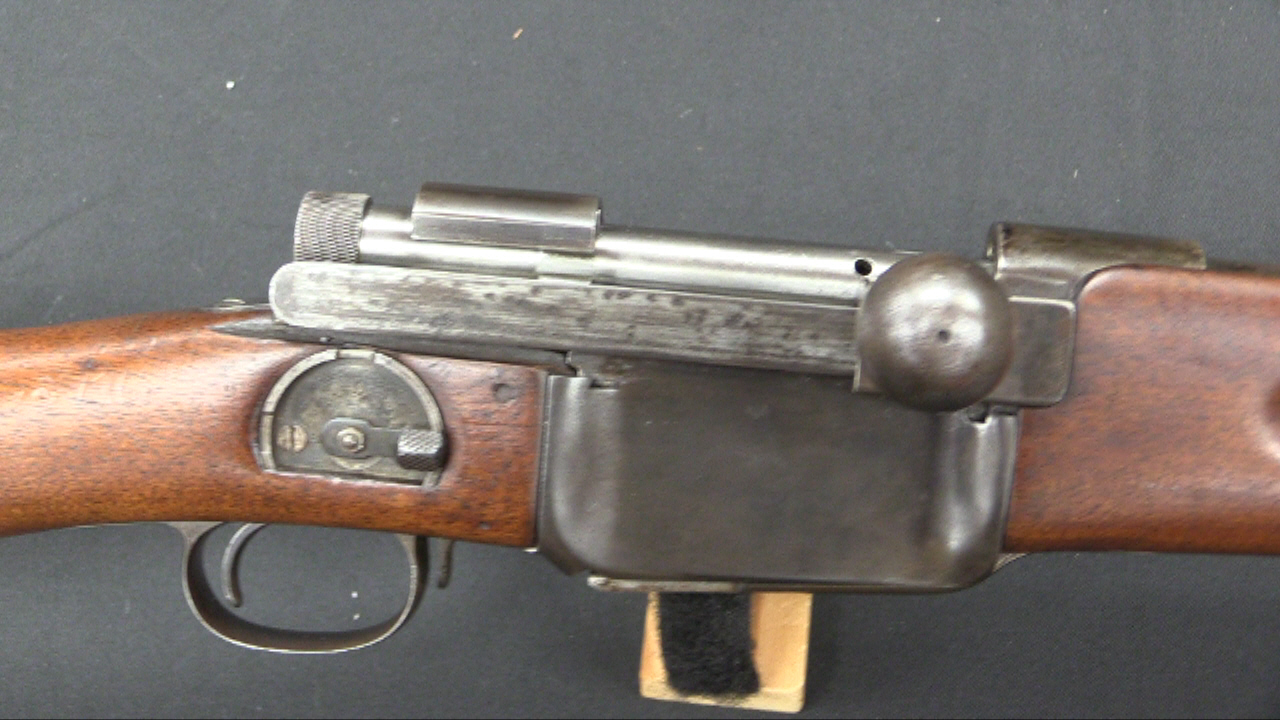Mexico has more of a history of domestic arms design and production than many people expect – from the many designs of Manuel Mondragon to Rafael Mendoza’s light machine guns, the Trejo machine pistols, and the recently developed FX-05 Xiuhcoatl combat rifle. Another indigenous Mexican firearm still in current production is the Mendoza HM-3 submachine gun, designed by Hector Mendoza, son of Rafael Mendoza.

The HM-3 is not a particularly innovative or exotic submachine gun, but simplicity is certainly a quality worth pursuing in firearms design, and a gun need not use novel mechanisms to be reliable and effective. The HM-3 is chambered for 9mm Luger, using a 32-round double-stack single-feed magazine which is held in the pistol grip of the weapon. A basic heel release holds it in place. The barrel is fixed in place, and the gun’s mechanism is simple blowback. The bolt wraps around the barrel, allowing the design to be relatively short and compact but maintaining enough mass in the bolt to function. In fact, on this early version of the gun the body of the bolt is fully exposed, and the front sight is mounted to it.

The HM-3 fires from an open bolt, with a selector lever allowing single shots or full automatic (or safe) modes. A grip safety at the back of the pistol grip prevents accidental firing. Unlike most wire-frame stocks, the Mendoza’s does not fold to the side, but is permanently fixed in place (again, on this early version – later variants included folding stocks).
The HM-3 was put into production in the 1990s, and modified variants remain in production today. These current models use a front handguard extended to wrap around the bolt and barrel and also act as a front sight mount (allow much better potential accuracy than having the sight mounted on a constantly reciprocating bolt). They are available with folding stocks, multiple barrel lengths, some in semi-auto only for police forces, and in .380 Auto as well as 9mm chamberings.
Technical Specs
Caliber – 9mm Luger
Magazine capacity – 32 rounds
Overall length – 25 in (635mm)
Barrel length – 10 in (255mm)
Weight (without mag) – 5.9lb (2.69kg)
Weight (fully loaded) – 7.4lb (3.35kg)
Rate of fire – 600 rounds/min
Manuals





This actually has rather nice lines…I wonder how they shoot?
The Mexicans were pretty creative back at the turn of the century. Another great Mexican firearm was the Obregon pistol: https://www.forgottenweapons.com/other-handguns/obregon/
The FX-05 was just an improved G36 with SCAR like ergonomics. Playing with one firsthand, it pretty crude, far from HK quality.
Shame that Mexico went from an advancing culture to a third world, corrupted culture. For now, we’ll enjoy their past.
Just a question for you! Have You ever been in México!? Cause i Dont think so And there are no corruption In América right! You canknow Speak Whatever You Want but do It responsably and with certain knowledge Not just for whatnow you Have seeing in the media
Mendoza designed and built a little single shot .22lr pistol with a grip like a Colt SAA along with distinctive side loops for extra cartridges. It functions and shoots well, even if it is not very attractive.
Pictures of current production ‘Cobra’ and ‘Bulldog’ submachine guns in 9 mm and .380 ACP respectively (with folding stocks) can be found on Maxin Popenkers site:
http://world.guns.ru/smg/mex/cobra-e.html
I see some family resemblance….I’d love to try the Cobra.
Can someone who is familiar with both, contrast this with the Uzi? Not knowing much about either one, they look a lot alike besides the shoulder stock.
Now why the hell would Mexicans build guns when we all know that Holder and his cronies will give them as many as they would like.
Now that’s Funny 🙂
kinda cliched at this point though isnt it
Precisely for that for not Having to depend on The supply From the “friendly ” of your goverment And Its hidden porppouses
This was one of the first submachineguns that I took an interest in in grammar school in the late ’60s. I think either “Guns” or “Shooting Times” did a feature on SMGs (actually borrowed from “World’s Submachineguns and Machine Pistols”, I think.)and the Mendozas were cited.
I seem to recall some sort of Mexican anti-terrorist/political police unit called “the White Brigades”. I have a vague recollection of a story about some of them pulling up to a curb and piling out of a Cadillac (Eldorado?) and hosing down some unsuspecting revolutionaries with their Mendozas. This is from almost forty years ago, so it’s kind of hazy at this point.
this is wildly off topic but I didnnt think it warrented an email. douse anyone know anything about these odd looking 7.65×25mm Borchardt cartridges in the picture in this link 7.65×25mm Borchardt
sorry link didnt post http://www.pakguns.com/attachment.php?s=518e9d847d1f8bb81c7a310f4e29bbe7&attachmentid=16391&d=1356894832
GIYF.
Hugo Borchardt, being a rather difficult person and easily offended, would not take any criticism on his design and refused to develop it any further. His employers then tasked his assistant Georg Luger, and the rest is history.
For his 7.63×25 Borchardt cartridge Hugo received neither royalties nor recognition when the DWM used the design for their pistol rounds (7.63×25 Mauser, 7.65×21 Para, 9×19 Para).
The current version of the Mendoza HM-3 appears to be simple, uncomplicated, practical, workman-like and durable. It doesn’t break new ground and is not a revolution in small arms. It may not be the most ergonomically-friendly or visually-attractive SMG out there. But, by most accounts, it works, and works quite well with good firepower, relatively low felt recoil, reasonable accuracy and decent reliability — which is more than one could say of a great many SMG designs, including a lot of “fancier” guns. Admittedly, I still have reservations — insofar as military battlefield scenarios are concerned — about the exposed bolt, even in the newer wrap-around versions.
Perhaps someone on this site with real hands-on field experience with the HM-3 would care to elaborate more clearly on this weapon and its strengths and weaknesses?
Many thanks in advance!
My quick take on “exposed bolt” would be that it is a good way how to promote cooling (should we say to offset ‘warm climate’ of Mexico).
There was recently discussion of future of SMGs in most developed nations armies, with question mark. In case of less affluent nations (in terms of relativity of perception) they are and will be well tool of power and its opposition for times to come. This specimen is good example.
That’s a pretty relevant point regarding the additional cooling factor, although I would have thought that firing from an open bolt would have been sufficient under most operational circumstances.
exposed bolts and the big slots down the spring housings of some SMGs are features which strike me as lost opportunities.
SMGs/carbines which have a sheet metal or tubular receiver which covers everything bar ejection and mag ports, and have none reciprocating cocking handles, manage to minimise potential for accidental discharge due to a snagged bolt or handle, and avoid cut, jammed, burnt or bruised fingers from trying to fire the thing from an awkward position.
steel tube or sheet steel is relatively cheap to buy and fabricate, and it adds a little useful non reciprocating weight to the gun, as well as forming a strong chasis to fix sights stock, grips etc together.
I know that patchett used the cocking handle slot in the Sterling as an exit point for dirt, but without the cut, that dirt would have had a lot harder time getting into the gun.
There is an argument that an encasing steel receiver might become sufficeintly dented to snag the bolt.
to a large extent that can be overcome by having the bolt run on guide bars,rather than on the receiver itself, these can either be stamped into the receiver, or as separate rods as in the US M3 “grease gun”
with any gun, there will always be accidents which will render it un useable – however it is built. accidentally driving over it is one such scenario.
Good analysis of the pros and cons of an exposed bolt mechanism versus a covered ( and protected ) one. Thank you, Keith.
The front sight mounted on the bolt body? That’s a truly bizarre design choice.
Another prime example is Wz.63 RAK in 9mm Makarov.
http://www.ebay.com/itm/WZ-63-PM-POSTER-TECHNIQUE-DIDACTIQUE-/261018147163?pt=FR_YO_Collections8militaria_DocumentsMilitaria&hash=item3cc5e4d95b
This is to me true machine-pistol without pretence and damn effective too,
In your professional opinion, how would you rate the Wz.63 RAK against the vz.61 Skorpion? They are both excellent compact SMG’s, and choosing between the two is like six of one and half-a-dozen of the other, so to speak.
I think you are close to the score Earl. Personally, I did not use during my military training either one; just in practical training as armorer I had some touch on vz.61. They are two different ways how to tackle same task while ’61’ is little more compact. The latter gun was used primarily by aircrews and special reconnaissance units. The Polish gun was used by drivers and tank crews. This does not intend to carry over a stigma of level of relative ‘sofistication’ one way or the other. If I had to make a choice my pick would be likely the Polish gun. The reason is its ruggedness and calibre.
Yes, a most difficult choice. Thanks for your input, as always!
BTW, Czechpoint-USA is now importing a new semi-automatic version of the Skorpion chambered in .380 Auto as an alternative to the original .32 ACP caliber. Both versions are built by CSA in the Czech Republic and can be viewed at http://www.czechpoint-usa.com. There are a couple of interesting modifications on the .380 version, such as elimination of the drop-free magazine and choice of a translucent or black polymer straight-sided magazine instead of the curved steel-bodied magazine.
Yeah, I saw this version, to my considerable surprise, first time in 1996. The breech is still dynamically ‘locked’ so there must be enough (just about?) resistance in that light bolt.
I also read some time ago testimonies of people who have used of still are using original Skorpion. They generally liked it with some reservation this being somehow not always well operating safety mechanism. I do not recall details though. Well, we all know that safety issues are on forefront of attention with open bolt SMGs.
Hmm, looks like an SA24 met a Madsen 45… I’ll take one! Why the single feed may, I wonder?
a fair question and one which has been much on my mind of late*
It possibly dates back to the WW1 expedient of using the trommel (drum) mags from artillery Lugers for early German SMGs.
Magazines are tricky things to get right, so using an existing mag was an obvious way of reducing development time.
Once it came time to fit stick mags to the SMGs, new mag housings could be installed pretty easily,
but, the narrow feed ramp and narrow feed tab on the bottom of the bolt, which serves to push the top round out of the mag, and then keep the next round held down until the bolt recoils again,
they’d need to be changed, and the whole chunk of development time getting reliable feed, which was avoided by using trommel mags, would be incurred. So the single feed position stayed.
at the start of WWii, Britain simply copied a Schmieser single feed position mag, which found its way into the STEN.
After the war, STEN and the German equivalent mags were plentiful (they probably still are) and provided a way for others to avoid the development time needed to get their own mag design to feed reliably.
Ironically, some expedients are disgustingly long lived. Most of the world’s railways are 4’8 1/2″ track guage.
That dates from the early dominance of the Stephenson family’s railway engines and wagons.
The Stephensons used that guage, because that was the guage of the pre existing tram ways used in the coal mines in north east England (some English railways long pre date steam locomotives).
The colliery tram ways used that guage because that was the guage that horse carts and wagons used.
Horse carts and wagons were built to that guage to fit the ruts in the roman roads which still form the basis of Britain’s road network.
Those ruts were made by Roman chariots and horse carts, almost two thousand years ago.
I don’t know where the Romans inherited that track guage from
* http://youtu.be/Vkw2DdoskPY (it’s silly)
Is it safe to assume that by this you mean to take into account the lateral ( side-to-side ) swing of both backsides in question as they proceed on their merry way, and not merely the static width thereof? If so, a truly historical joke regarding modern civilization and its perceptions of fact would have been perpetrated to no uncertain degree :).
Seems like yet another original late eighteenth century “standard guage” wooden tramway has been found:
http://www.thejournal.co.uk/news/north-east-news/river-tyne-200-year-old-5325105
The Mendoza 7mm is mentioned by Thomas Pynchon in Gravity’s Rainbow
Forgotten weapons when you want i could provide clear Pictures or detailed ones from the bulldog model because i own one. Simply in construction And very handy.